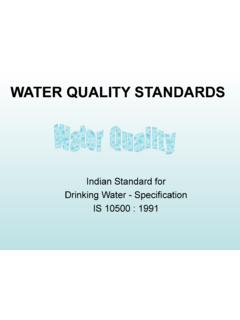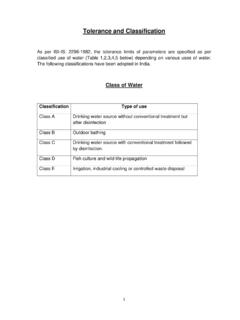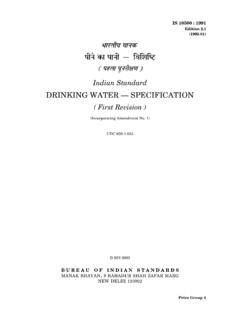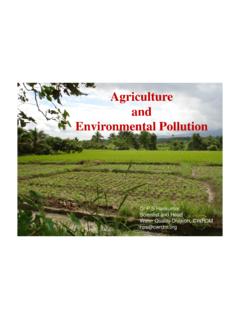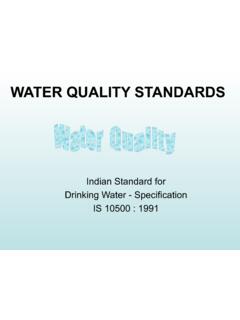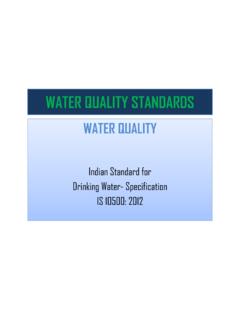Transcription of GROUND WATER EXPLORATION- AN INTRODUCTION.
1 GROUND WATER EXPLORATION- AN INTRODUCTION. A PRESENTATION BY BADRINARAYANAN, GEOSCIENTIST, B SQUARE GEO TECH SERVICES, KOLLIDAM, SIRKALI TALUK, NAGAI DISTRICT, TAMILNADU- 609 102. 1. MOB- 94430 46102, E-MAIL : PRELUDE. WATER is one of the Mankind's most vital resources. An adequate supply of WATER is one of the pre-requisites for development and industrial growth. In areas where surface WATER is not available, Groundwater constitutes significant part of active fresh WATER resources of the world and is obviously dependable source for all the needs. The stress on WATER resources started due to exploding irrigation, domestic and industrial demands. The finite WATER resources are being explored to quench the thirst of millions of the populace. 2. WATER NEEDS AND. CONSUMPTION. In a developing country like India, the minimum daily requirement of a person is 200 litres for domestic use, while an equal or large amount will be needed for other purposes.
2 It is estimated that out of the total of 1122 billion cubic meters of WATER utilized in India annually, 430 billion cubic meters is met from surface sources and the rest is met from GROUND WATER resources. [Source, Hand Book for TWAD Hydrogeologists, 2002]. 3. GROUND WATER . GROUND WATER is a mineral that occurs in the subsurface within sediments, rocks, desertic sand, ice & snow. It gets replenished from meteoric precipitation. GROUND WATER is most widely distributed precious resource of the Earth. Among the natural WATER resources, GROUND WATER forms an invisible component of the system. 4. GROUND WATER . 5. ORGIN OF GROUND WATER . PRECIPITATION. INFILTRATION. RECHARGE. 6. GROUND WATER EXPLORATION. Though the GROUND WATER resources are widely distributed, Nature does not provide GROUND WATER at the places of our choice.
3 The occurrence and distribution of GROUND WATER resources are confined to certain geological formations and structures. The GROUND WATER at all locations may not be directly used if the quality of WATER is poor. All these problems can be solved using proper exploration techniques. Explore is derived from Latin word explorare meaning- to learn or investigate. The proper exploration of GROUND WATER resources involves apart from source location, the well design and construction. These are all an integral part of the scheme of exploitation & management. 7. GROUND WATER EXPLORATION- HISTORY. The development of WATER resources seems to have started first in India & Egypt. Open wells for irrigation & drinking WATER were in common use in India as early as in the Mahabharata period about 6,000 years ago.
4 Exploitation of GROUND WATER on modern lines can be said to have started at the turn of the century. The first tube well was sunk in 1935 in Uttar Pradesh. 8. OBJECTIVE OF GROUND WATER . EXPLORATION. Usually the GROUND WATER exploration projects pass through the phase of regional surveys, leading to detailed surveys and ultimately resulting in the exploitation of GROUND WATER by means of bore holes, wells. The main objective of these surveys is to study and understand the hydrological cycle of the region, to have an overall concept about the type, nature & number of aquifers, the quality of GROUND WATER . 9. METHODS AND TECHNIQUES OF GROUND WATER EXPLORATION. GROUND WATER EXPLORATION. AERIAL SURFACE SUB-SURFACE ESOTERIC. 10. METHODS AND TECHNIQUES OF GROUND WATER EXPLRATION. AERIAL SURFACE SUB-SURFACE.
5 ESOTERIC. 1. Geological. 1. WATER divining. Methods. Methods. IRS 2. Hydrogeological. 2. Astrological. methods. imagery. 3. Tracer 3. Biophysical. Methods. techniques. magnetic 4. Geophysical [EM] techniques. Methods. Logging techniques. a). Electrical & EM. b). Seismic. c). magnetic . d). Gravity. Methods. 11. Methods. 1. AERIAL METHOD. The most convenient methods for reconnaissance surveys of large areas aimed at identification of watershed characteristics of basins and locating prospective areas are the methods of aerial exploration. 12. REMOTE SENSING. Remote sensing refers to obtaining reliable information about Earth's surface without physical contact, through the use of Electro magnetic radiation [EMR] as source energy and the sensors to record the images. The aerial photos are those taken from an aircraft mounted with the cameras, which shoot directly the terrain within the visible spectrum or in the near infrared region.
6 The photos are taken in panchromatic [black & white], color & infrared. The RS data are found extremely useful in identifying the various geologic, geomorphic units, structures like faults, lineaments, joints, fractures, folds and drainage which are important since they control the movement and occurrence of GROUND WATER . 13. SATELLITE IMAGERY. 14. AERIAL PHOTOGRAPHY. GROUND WATER investigation of an area requires the nature of lithological units, their structural dispositions, geomorphic set up, surface WATER conditions & climate of the area which can be studied through satellite images & aerial photographs that provide detailed information about a large part of the surface of the earth in a very short time. Remote sensing data do not directly detect deeper subsurface resources, but RS techniques have been effectively used in GROUND WATER exploration.
7 15. AERIAL PHOTO SURVEY. 16. ADVANTAGES OF AERIAL PHOTO SURVEY. 17. PHOTOGEOLOGY. 18. AERIAL PHOTO. 19. AIRBORNE ELECTROMAGNETIC. SURVEY. The advantage of airborne system is the rapid data acquisition over large areas & thus the technique is ideally suited to regional studies. Airborne electromagnetic survey [AEM] provides rapid assessment of the bulk resistivity of the subsurface of the large area. AEM survey is conducted from the aircraft @ height range of 60 to 120 meters. Generally in airborne electromagnetic survey [AEM] the primary magnetic field is generated through transmitter coil and the secondary magnetic field is picked up by the receiver coil. 20. AIRBORNE SURVEY. 21. AIR BORNE EM SURVEY. PRINCIPLE. 22. 2. SURFACE METHODS. The most common and time tested methods are the surface variants of different techniques from geology, geomorphology, hydrogeology, geophysics etc.
8 These methods are applied where the purpose is the detailed study of the distribution of potential WATER bearing zones in lateral and vertical directions. 23. GEOLOGICAL METHODS. The GROUND WATER occurrence and movement mainly depend on the geology of the area. Geological studies are very much essential. The type of terrain, rock formations, lithological units, geological structures like lineament, fold, fault, joints and fracture system have to be studied in depth. Only after the geological investigations, the type of geophysical method to be conducted may be decided. 24. GEOMORPHOLOGICAL. METHODS. After a thorough study of the satellite imagery and geomorphology map, a field check is highly necessary to know the geomorphological features to assess the GROUND WATER potential. The geomorphic units like pediments, flood plains, drainage pattern, soil types, lineaments which primarily control the occurrence, movement and potential of GROUND WATER have to be investigated in detail.
9 25. HYDROGEOLOGICAL METHODS. The GROUND WATER potential of an area mainly depends upon the hydrogeological set up, for which a detailed & systematic hydrogeological hydrogeological survey is a prerequisite. Well inventory study is very important in any GROUND WATER exploration exploration programme. Especially in hard rock terrain GROUND WATER confines to the weathered weathered mantle, joints and fractures. The weathering thickness, joint & fracture system of the area ought to be studied in depth. WATER level measurements, WATER level fluctuation studies are the the important factors in the assessment of GROUND WATER potential. Only by a systematic hydrogeological study, the GROUND WATER abstracting abstracting structures like open well, bore well, tube well have to be finalized. finalized.
10 The recharge and discharge areas ought to be identified. The fluvial hydrological studies like the river & stream flows, whether it is perennial etc details are important in quantifying the potential. potential. 26. GEOPHYSICAL METHODS. 27. GEOPHYSICAL METHODS. Resistivity. Electromagnetic. 28. WHAT IS GEOPHYSICS ? The study of the earth using quantitative physical methods, remote insight into the earth. We designate the study of the earth using physical measurements at the surface as geophysics. In a broader sense, geophysics provides the tools for studying the structure and composition of the earth's interior 29. GEOPHYSICAL INVESTIGATION. Geophysical methods comprise of measurement of signals from natural or induced phenomena of physical properties of sub surface formation. Various physical properties that are made use of in different geophysical techniques are electrical conductivity, magnetic susceptibility , density, elasticity &.
